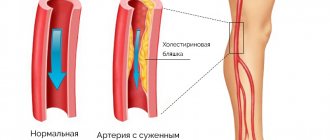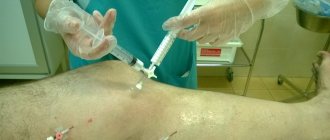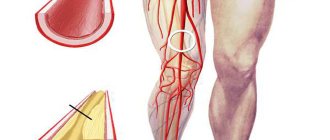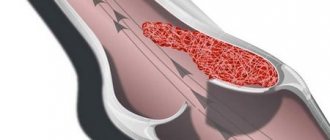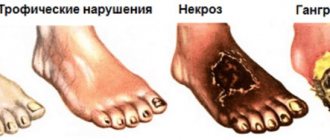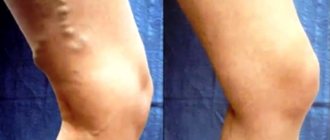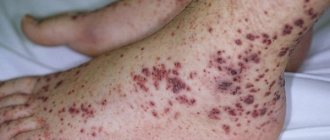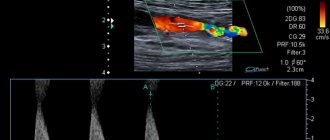Example of ulceration
Varicose veins are a pathological condition that leads to changes in their width and length. Blood flow is disrupted and the valves stop working correctly. Diseases appear as a result of pathologies of the vein walls.
Trophic changes in the skin with varicose veins are not uncommon, but they usually appear only in an advanced state. For a speedy recovery, it is recommended to combine methods of traditional and traditional medicine in treatment.
Causes and clinical picture of trophic disorders
The most common “culprits” of problems with the nutrition of the tissues of the affected area are the following diseases:
- varicose veins in the legs;
- diabetes mellitus, type 2;
- obliterating atherosclerosis;
- infectious processes of a chronic nature;
- cardiovascular failure with edema.
Predisposing factors of the pathological process can be the following body conditions:
- overweight;
- late pregnancy and the postpartum period;
- excessive physical activity;
- traumatic injuries.
The first signs of disruption of soft tissue trophism in the area of the affected area are indicated by a change:
- skin color (redness or darkening);
- elasticity of the skin (it becomes thinner, shiny, peeling);
- itching, burning and pain in the legs;
- swelling;
- the appearance of bubbles with transparent contents.
If the first symptoms of venous insufficiency or other problems with blood vessels and innervation of the legs were ignored, deep damage to the skin and subcutaneous tissue in the form of ulcers with purulent contents may subsequently occur.
Reasons for appearance:
- Chronic venous insufficiency. As a rule, trophic defects develop as a result of CVI, observed against the background of varicose veins of the legs, post-thrombophlebic disease, congenital angiodysplasia and Klippel-Trenaunay syndrome.
- Diseases of the arteries of the lower extremities. In conditions and diseases such as macroangiopathy, obliterating atherosclerosis, thromboangiitis, diabetic damage to blood vessels, Martorell syndrome, the appearance of ulcers is observed at a certain stage of the formation of vascular damage.
- Various neoplasms that disrupt the trophism of the skin.
- Arteriovenous fistulas. As a rule, trophic defects are observed when tissue is damaged due to circulatory disorders due to soft tissue injuries, as well as congenital Parkes-Weber syndrome.
- Disorders of lymphatic drainage. The formation of defects can occur with primary and secondary lymphedema. Tissue damage of this nature can be observed when the flow of lymphatic fluid is disrupted due to filariasis.
- Traumatic skin damage. Ulcers can develop due to thermal and chemical damage to the skin. The formation of such a defect can also occur after electric shock to the human body. Gunshot and mechanical injuries can lead to the formation of tissue defects. Dangerous are osteomyelitic and decubital injuries, amputation of limbs, postoperative scars that disrupt tissue trophism. Purulent tissue defects can also be the result of injections of various narcotic and chemical substances and radiation therapy.
- Disorders of the nervous system. So-called neurotrophic ulcers often develop against the background of tissue damage to the spinal cord, brain, and peripheral nerves. The appearance of such defects may be associated with damage to peripheral nerve endings due to infectious, toxic diabetic damage.
- General diseases. Diseases against which such defects occur include systemic autoimmune diseases, chronic heart, kidney and liver diseases. Along with this, the development of such skin defects can be caused by chronic anemia, endocrinopathies, gout, vitamin deficiencies, amyloidosis, blood diseases, etc.
- Infectious viral and parasitic skin lesions. The defeat of pathogenic microflora can lead to tissue infiltration and the formation of a purulent skin defect.
Trophic ulcers are, as a rule, the most severe complication of primary diseases, so it is very important for patients to promptly recognize the formation of such a skin defect.
Types of trophic changes in the skin of the legs
The appearance of various types of disturbances in the trophism of the outer integument and underlying tissues requires close attention of specialists and immediate treatment of the underlying disease and its consequences.
Lipodermatosclerosis
Edema of the lower extremities of venous or cardiac origin provokes a change in the permeability of the vascular wall, as a result of which the liquid part of the blood penetrates into the subcutaneous tissue and causes gradual destruction of cellular structures. The skin thickens and becomes painful.
Due to lack of oxygen, adipose tissue cells are replaced by connective tissue, and chronic inflammation develops. The lack of therapeutic measures over time leads to trophic disorders in the form of ulcers.
Hyperpigmentation
Darkening of the skin is one of the initial signs of developing trophic changes in the form of ulcers. Pigment spots appear due to the destruction of blood cells penetrating from the vascular bed into the surrounding tissues. Pigmentation is most often located on the inner surface of the legs.
Microbial eczema
Congestion in the veins creates favorable conditions for the development of an infectious inflammatory process on the skin. Bacterial pathogens (streptococcus, staphylococcus) provoke the development of an allergic skin reaction against the background of weakened immunity.
These phenomena lead to the development of eczematous lesions. The patient is bothered by itching, which intensifies at night and in stressful situations. Due to scratching, the inflammatory process progresses, which manifests itself as a pustular lesion with the formation of an ulcer.
Skin atrophy
In places of increased pigmentation, the cover gradually becomes lighter, which occurs as a result of atrophic processes. A sharp compaction of the skin layers leads to the formation of depressions and irregularities, visually the leg decreases in volume.
The terminal stage of trophic disorders is called white atrophy.
Trophic ulcers
Violation of the integrity of the epithelial layer leads to the formation of a skin defect with the formation of an ulcer. Penetration gradually develops, affecting the deep layers of the skin, as well as subcutaneous fatty tissue and muscles.
Varieties
Due to the disruption of blood flow in the legs, trophic changes appear on the skin, which can become acute or chronic. And even after a completely successful surgical intervention, obvious signs of acute eczema and trophic ulcers remain on the patient’s skin. There are several types of trophic changes in tissues:
- trophic ulcers;
- skin atrophy;
- bacterial eczema;
- varicose dermatitis;
- hyperpigmentation.
Lipodermatosclerosis
Due to constant swelling, the process of nutrition of epidermal cells, venous outflow is disrupted, and pressure rises in the blood vessels. The composition of the blood (its liquid part, red blood cells, leukocytes and platelets) slowly passes through the walls of the veins, which are located in the skin and subcutaneous fat layer.
As a result, all components begin to deteriorate, and a long-term inflammatory process gradually develops, which over time can lead to a slow delivery of nutrients to the cells and subsequently to tissue necrosis.
Hyperpigmentation
Most often, trophic changes occur in the ankle area and in the very lower part of the lower leg. A sick person exhibits these symptoms:
- The sensitivity of the skin decreases.
- The skin becomes denser.
- It darkens, gradually acquiring a light brown tint.
Hyperpigmentation is not so scary; it is important to pay attention to external changes in the skin of the extremities in time and take action.
Microbial eczema
When blood stagnates in the veins, it is very difficult for the immune system to cope with pathogenic microbes that multiply on the patient’s skin in record time. For this reason, fungus and globular streptococcus actively develop at the sites of inflammation. The immune system responds to these irritants with severe allergies and the sick person begins to develop bacterial eczema.
When eczema worsens, the skin becomes very itchy, not only in the areas affected by the dangerous disease, but throughout the body. Small films separate from the skin, wounds develop that are very similar to abrasions, for this reason the patient’s well-being and quality of life sharply decrease.
Skin atrophy
Skin covered with pigment spots, in places where lipodermatosclerosis appears, gradually acquires a lighter shade, but this does not mean that varicose veins have stopped growing. This is associated with the progression of white atrophy. Over time, the skin becomes denser upon palpation, and small pits appear. The lower limb in the affected area may decrease in size.
Trophic ulcers
They increase in volume very quickly, do not heal for a long time, and sometimes become chronic. Periodically, the trophic ulcer heals a little, but after a while it begins to bleed again and secrete light yellow pus. When scratching, pathogenic bacteria enter trophic ulcers. In this case, the sick person urgently needs to make an appointment with a qualified phlebologist and undergo a thorough examination.
Diagnostics
Modern examination methods will help to identify the condition of veins and arteries:
- duplex scanning of blood vessels;
- ultrasonography;
- computed tomography of veins;
- X-ray method with the introduction of contrast agents into the vascular bed.
To identify the nature of the infection, it is necessary to do a bacteriological analysis of the purulent contents from the wound surface. The results obtained will allow us to select etiological treatment with local drugs.
A clinical blood test will show the degree of the inflammatory process (the number of leukocytes and ESR), as well as the severity of the allergic reaction to eczema (eosinophil content).
Treatment methods for varicose veins
In the early stages of the disease, minimally invasive methods are rarely used, which is why medications are the basis of therapy. In order to improve the condition of the veins, it is recommended to use medications from several groups: venotonics and angioprotectors.
Treatment result
Medications can relieve unpleasant symptoms - pain, swelling, inflammation, fatigue. It will be possible to increase the elasticity of blood vessels, the blood will become more fluid, and blood clots will not begin to form.
The following drugs may be prescribed for treatment:
- troxevasin;
- Venolek;
- phlebodia 600.
Therapy can be supplemented by wearing compression garments.
Important! Only a doctor can prescribe medications; self-treatment can lead to a worsening of the condition.
Hirudotherapy
In order to eliminate the disease at an early stage without surgery, hirudotherapy, that is, treatment with leeches, can be used. Their saliva contains hirudin, and after a bite it enters the bloodstream. Viscosity indicators decrease, the development of thrombosis is prevented.
Treatment
Health measures have a pronounced effect with a complex effect directly on the lesion and the entire body. Recovery usually does not occur quickly: it takes a long time for the ulcer to epithelize, so you need to be patient and persistently follow the advice of specialists.
General recommendations
To get rid of skin damage due to venous disease, you will need to reconsider your lifestyle:
- tidy up your diet;
- adhere to the work and rest schedule;
- get rid of bad habits;
- use an elastic bandage for problem areas.
Compliance with hygiene recommendations helps prevent infection of the wound surface.
Medicines
Drug treatment improves venous circulation and metabolism in soft tissues, affects the causative agents of the infectious process in the areas of ulcer formation.
Systemic action
To normalize venous blood flow and tissue trophism, the following means are needed:
- venotonics (Detralex, Phlebodia, Troxevasin, Venoruton);
- drugs to improve capillary blood circulation (Pentoxifylline, Nicotinic acid, Capilar, Aescusan);
- medications that stimulate trophic processes in affected tissues (Actovegin, Solcoseryl);
- broad-spectrum antibiotics (cephalosporins, fluoroquinolones, semisynthetic penicillins);
- antihistamines (Fenkarol, Cetrin, Claritin);
- antioxidants (Tocopherol acetate, Succinic acid, Mexidol).
The duration of the course is determined by the attending physician.
Treatment periods can be long (for venotonic drugs). Antibiotic therapy is carried out in conjunction with intestinal probiotics and antifungal agents.
For topical use
Ointments and creams applied directly to the lesion have a positive effect when the first signs of the disease appear.
To cleanse the wound surface of necrotic masses, Iruksol ointment is recommended. Chloramphenicol (an antibacterial agent in the drug) suppresses the activity of pathogenic microflora.
Local preparations actively inhibit the activity of microorganisms:
A modern way to fight infection is Branolind tissue wipes, which have an effective disinfectant and anti-inflammatory effect.
To wash the ulcer and free it from necrotic tissue, the following disinfectant solutions are used, which can be used to soak the dressings:
- Potassium permanganate;
- Hexamidine (3%);
- Hydrogen peroxide (3%);
- 0.25% silver nitrate;
- Dioxidine;
- Miramistina.
Ointments have wound healing properties:
In cases where it is urgently necessary to relieve the inflammatory process, corticosteroid-based products are used (Celestoderm, Lorinden A, Sinaflan). These ointments are not recommended for long-term use, as they can cause a decrease in adrenal function.
Surgery
In situations where conservative therapy does not have the expected effect, the issue of surgical treatment of ulcers with trophic disorders is decided.
One of the ways to restore venous circulation is to remove the dilated venous node. An alternative to this effect is sclerosis of the affected vein and laser surgery.
To cope with trophic disorders of the skin and underlying tissues, the necrotic area with the ulcer is excised. This accelerates regeneration processes and stimulates repair.
ethnoscience
Compresses and lotions based on the following medicinal plants can produce a therapeutic effect:
- chamomile;
- calendula;
- St. John's wort;
- sage;
- oak or white willow bark.
Oil from sea buckthorn and rose hips has a pronounced regenerating effect.
Herbal remedies from the arsenal of alternative medicine should be used with great caution and only after consultation with your doctor.
Inflammation of the skin of the legs with varicose veins: treatment methods
Additional education:
"Emergency Cardiology"
1990 – Ryazan Medical Institute named after Academician I.P. Pavlova
Contacts
Pathological changes in the veins of the lower extremities are considered common, especially among athletes and the elderly. If the blood supply to a certain area of the skin is disrupted, venous pressure increases and varicose veins occur.
The dilation of the veins becomes very noticeable, blood vessels appear, and changes in the process of cellular nutrition (trophism) occur. When the disease is not treated for a long time, trophic changes in the skin occur with varicose veins, which are accompanied by damage to the skin.
In the affected area, significant increases in skin pigmentation, dermatitis, eczema and trophic ulcers are observed.
When treating trophic changes in the skin using traditional methods in combination with drug therapy, the patient has a better chance of a speedy recovery.
Types of trophic changes in the skin of the legs
Against the background of impaired venous outflow in the lower extremities, trophic skin changes occur, which are characterized by a chronic course. And even after successful surgical treatment of the disease, external signs of ulcers and eczema do not disappear. Trophic disorders of soft tissues include:
- lipodermatosclerosis;
- hyperpigmentation;
- microbial eczema;
- skin atrophy (exhaustion, loss of vitality);
- trophic ulcers.
Treatment
Patients with varicose eczema need a comprehensive treatment approach: drug and local therapy, balanced nutrition, a healthy lifestyle, distribution of work and rest.
For trophic ulcers, surgery is indicated. After which the ulcers quickly heal. But darkening and thickening of the skin remain forever.
Compression garments are recommended for everyone, without exception.
Local therapy
This type of treatment involves the use of special creams, ointments, lotions and baths. They are especially effective in the initial stages of inflammation of the skin with varicose veins. Local preparations moisturize, soften and disinfect the affected area of the skin.
It is also necessary to monitor the hygiene of problem areas of the skin. Wash the skin with neutral soap, dry with sterile wipes or cotton wool, treat with solutions of antiseptic and antimicrobial agents.
The use of hormonal drugs helps relieve inflammation and reduce itching.
Drug treatment
Local therapy in combination with oral medications is effective in treating the problem. Drug treatment consists of the following medications:
- antihistamines;
- antibiotics;
- sedatives;
- venotonics and vascular drugs.
Surgery
Indications for surgical intervention are advanced forms of skin changes that do not respond to conservative therapy. The patient undergoes vein removal, minimally invasive surgery (operation through pinpoint punctures of tissue) or uses laser treatment methods and sclerotherapy.
ethnoscience
To begin treating inflammatory processes of the skin with traditional medicine, you must first consult a doctor. If the patient has injuries and deep ulcers, folk remedies can only worsen the situation.
Traditional therapy suggests the use of natural ingredients, vegetable oils, tinctures of medicinal herbs, and plant juices. As a rule, decoctions are prepared from chestnut extract, grape leaves, chamomile and calendula flowers, oak bark, which have disinfectant, anti-inflammatory properties, and also heal wounds.
Vegetable oils from almond, coconut or wheat germ moisturize problematic skin after hygiene procedures.
Preventive actions
Preventive measures for a very life-threatening complication of venous pathology are of great importance. Moderate physical activity helps to increase the tone of the muscles and veins of the legs: walking, running, swimming.
Massages, contrast showers, and dousing with cool water will also be helpful. You should not constantly sit or lie down, as movement increases microcirculation and promotes wound healing.
Wear comfortable shoes that fit your feet, choose clothes exclusively from natural fabrics, especially for eczema and ulcers.
Inflammation of the skin of the legs with varicose veins is chronic, lasts for years and leads to irreparable changes in the skin. If changes in the skin are noticed in time, the doctor will conduct competent and correct therapy, which will stop the inflammatory process and even eliminate small trophic ulcers.
Source: https://CardioPlanet.ru/zabolevaniya/sosudy/izmeneniya-kozhi-nog-pri-varikoze
Forecast and prevention of trophic disorders
The appearance of trophic disorders with ulcers on the skin is a prognostically unfavorable sign, which indicates the ineffectiveness of previous treatment for varicose veins.
Therapy tactics include a complex effect using systemic drugs and local agents. If conservative treatment is ineffective within several months, a decision is made on the need for surgical intervention.
Prevention of trophic ulcers consists of timely treatment of varicose veins and compliance with recommendations for lifestyle correction.
Patients with a tendency to trophic disorders of the skin of the legs should wear clothes made from natural fabrics and regularly carry out hygiene procedures. Women should avoid wearing high-heeled shoes.
Diagnosis and treatment:
Treatment of trophic ulcers is primarily aimed at treating the underlying disease. Complex therapy involves the use of drugs both for internal use and for local treatment of the wound surface. Medicines intended for:
- improving blood circulation;
- normalization of trophism;
- reducing the risk of bacterial infection of the wound surface;
- increasing the regeneration rate;
- relief of pain syndrome.
Source: kama-med.ru
Clinical picture of the disease
This problem has many symptoms. Even the most minor trophic ulcer affects the venous system. The patient may experience heaviness in the limbs, increased swelling, muscle cramps, itching, and burning. At the site of the lesion, skin pigmentation increases, dermatitis and eczema occur. The affected skin has a “varnished” appearance, pain and tension appear. Lymphedema (impaired lymph outflow) progresses significantly. It is characterized by the appearance of small droplets on the skin, similar to water.
After some time, necrosis of the epidermis occurs on the skin area. This condition is called white atrophy. The patient may not immediately notice the damage because the change affects a small area of the skin surface. It takes on a reddish hue and moisture. A trophic ulcer is usually covered with a dry crust. In the future, if left untreated, trophic lesions on the skin will further increase and worsen. In the most advanced form, small ulcers merge into a common defect, and the entire surface of the skin is affected by a large number of advanced ulcers.
Diseases such as trophic ulcers progress not only on the surface of the skin; there are cases of damage deep into the wound. The patient has severe pain, pain in the calves or tendons of the limbs. Due to complications, osteomyelitis may appear.
Treatment of trophic ulcers with varicose veins is carried out in several ways:
- surgical intervention in case of neglected affected area of the ulcer;
- folk remedies;
- conservative methods (treating ulcers with antiseptics and ointments, eliminating necrotic tissue);
- physiotherapy;
- drug therapy.
In the absence of timely assistance, a trophic ulcer can cause serious complications and be life-threatening.
Pros and cons of traditional medicine
When starting to treat an ulcer with folk remedies, you should definitely consult a doctor. If you have serious skin lesions and deep ulcers, you should not turn to traditional methods for help, so as not to aggravate the situation. Often, alternative medicine recipes are used only to heal trophic ulcers or damaged skin areas.
Traditional medicine suggests using various natural ingredients, vegetable oils, tinctures of medicinal herbs, and the juice of some plants. There are exotic ways to get rid of ulcers. For example, one of them involves the use of raw meat. Experts do not recommend using such methods, as they can be harmful to health.
Effective methods of combating the disease
To ensure that the trophic ulcer heals quickly, use homemade ointments based on natural bee honey. To prepare this infusion, you need to mix 1 chicken protein and 1 spoon of fresh honey. Leave for 3 hours. Treat the affected area with hydrogen peroxide, then apply the prepared product to it and wrap the skin in cellophane. Cover the top with a clean bandage. Keep the compress on your feet for 8 hours. After that, replace it with a new one. Carry out all necessary manipulations under sterile conditions.
You can make yolk ointment. Mix chicken yolk and 5% iodine solution in equal quantities. Store the resulting mass in a cool place. Apply the ointment exclusively to the wound, avoiding contact with healthy areas of the skin. Do dressing once a day.
You can mix 100 g of spruce resin, fresh beeswax and lard. Boil the resulting mass. Dilute 1 liter of clean water and add 1 tbsp. l quicklime. Wash the ulcer with this liquid. Apply prepared fresh ointment to the painful area. Even the most complex and severe ulcers are treated with this ointment. They heal after 6 dressings.
Bath treatment has also worked well. You need to dilute potassium permanganate in water until it turns light pink. Keep the affected area of skin in it for 30 minutes. After this, dilute 100 ml of calendula with 1 liter of water and keep in this solution for 30 minutes. The last bath comes with eucalyptus tincture. After completing the procedure, apply a bandage to the ulcer.
You can pour 9 liters of boiling water into 1 kg of sifted birch ash. Leave for 2 hours. Immerse the sore leg in warm liquid for 30 minutes.
The method of treatment with compresses can also be effective. You need to mix 25 g of Vaseline with alcohol tincture of calendula and 1 cup of small calendula flowers. Apply the resulting mixture to the affected area of skin.
You can soak fresh cabbage leaves in natural sea buckthorn oil, apply to the ulcer and leave until the leaf dries completely.
Sometimes the treatment method is lotions. To do this, you need to grind fresh fern leaves in a meat grinder. Pour water and leave in a warm, brightly lit place for 6 days. Strain and treat the affected ulcers with a moistened soft cloth.
In the following recipe you need to add a few grams of powdered burnt alum to 100 ml of boiling water. Wash trophic changes on the skin with this solution. Alum perfectly treats ulcerative changes, tightens the affected edges and copes well with wound inflammation.
It has been proven by experts that patients who treat trophic ulcers using traditional methods get rid of the problem quite effectively if everything is done correctly and in a timely manner. After a full course of therapy, pink spots remain on the affected area. There is no need to further process or touch them. They will come off on their own in about 2 weeks.
Preventive actions
Prevention of various trophic changes lies in the treatment of diseases that contribute to their development. This may be chronic arterial insufficiency, varicose veins. It is necessary to avoid prolonged sedentary work, prolonged hypothermia, physical labor, heavy loads, and work in hot shops. Patients suffering from varicose veins should use elastic bandages or medicinal knitwear, and also fully follow all doctor’s recommendations. Often, trophic changes occur with poorly treated varicose veins. Therefore, you should be careful about the prevention of varicose veins.
The legs should be rested at the slightest appearance of symptoms, such as swelling. You can start using various gels or ointments. Don't forget about various diets and exercises. At the first signs of trophic ulcers, you should pay attention to the hygiene of the affected area.
Provided that changes in the skin are noticed on time and the treatment is carried out competently and correctly, small trophic ulcers can be completely eliminated.
Comprehensive, correctly carried out treatment allows you to avoid the occurrence of trophic changes.
Symptoms of varicose veins
At the initial stage of development of varicose veins, there are practically no symptoms, which is why many seek help late.
To prevent further development of the disease and to avoid complications, you should know the main signs that may be present:
- At the end of the working day, your legs swell. Shoes may become tight, after a full rest, this usually happens in the morning, the symptom disappears.
- Another characteristic symptom of varicose veins is the feeling of a cannonball that is shackled to the leg. There is a feeling of fullness in the calf muscles, especially after standing for a long time or after spending time at the computer. If you rest well and warm up, the symptom will disappear the next day.
- So-called hot sensations appear in the legs, or more precisely in the calves. Veins become very noticeable.
- Another warning indicating that something wrong is happening is leg cramps at night.
- Vascular inclusions in the form of spider veins appear under the skin of the legs; at first they are barely noticeable, but after some time they begin to become visible.
If you do not pay attention to all these symptoms and do not start treatment, numerous complications will begin to appear.
Diagnostics
If a man or woman sees at least one symptom listed above, it is necessary to consult a phlebologist. It is this specialist who deals with the treatment and examination of such problems.
In order to prevent complications, you should never delay visiting a doctor. The prognosis depends only on how timely therapeutic measures are taken.
Diagnosis begins with the doctor examining the patient and palpating the affected area. The next stage is an instrumental examination. As practice shows, a referral for Doppler ultrasound is given.
As an addition, tests may be taken. After the diagnosis is made, appropriate treatment is prescribed. Self-medication in this case is prohibited.
Varicose trophic skin changes: how to treat the disease
Heavy stress on the legs, which is regular, leads to the problem of varicose veins. Subsequently, if the problem is not treated, trophic ulcers appear on the skin. Such modifications appear as red or even blue spots on the skin and cause pain.
Trophic ulcers can be treated with medication or surgery; if the problem is not very advanced, a person is allowed to use traditional medicine methods. It is possible to be treated for the disease at home, but you must follow all the recommendations of doctors.
The concept of a trophic ulcer
When the circulatory mechanism is disrupted, stagnation processes begin in the veins.
This leads to dilation of blood vessels, varicose veins.
If a person is in no hurry to treat the presented problem, starting it, then trophic ulcers may appear on the skin, and they will not be present on the legs in a single form.
A trophic ulcer is a complication of varicose veins and has pronounced symptoms.
The problem can be described as accurately as possible as follows:
- the problem belongs to the category of complications that arise in advanced cases of varicose veins;
- trophic ulcer is a problem of severe damage to soft tissues;
- pigmentation of the skin in the affected area increases, and dermatitis or eczema additionally occurs;
- the skin on the affected area has a matte appearance.
This problem indicates that the blood in the vessels stagnates, the outflow of lymph is disrupted . The problem is accompanied by painful sensations, necrosis of the epidermis is observed, and a dry crust appears on the wound.
Note! If trophic changes in the lower extremities are not treated, then over time the problem can affect the muscles and this will cause incredible pain. In this case, the problem can only be treated surgically.
Symptoms
With serious trophic disorders, the affected skin becomes very thin, and the patient may receive various injuries, but these are not the worst manifestations of varicose veins:
- severe swelling and swelling;
- unpleasant itching, burning and unbearable pain in the affected area, the affected area of skin is much hotter than the whole body;
- heaviness in the legs, especially after long physical work and long walking over long distances;
- necrosis of the epidermis;
- bright red spots appear that are very itchy and over time change their color to dark purple;
- the affected skin is smooth on palpation and also slightly shiny;
- small bubbles form, which burst over time, and as a result of this process, erosion begins;
- through the skin pores, light yellow pus is secreted.
Trophic ulcers can form not only on the first layer of the skin, but can go far into the depths of bleeding wounds. A sick person experiences terrible pain in the tendons and calves of the lower extremities. The risk of inflammation of the bone marrow and soft tissues, which is caused by mycobacteria, increases.
What types of treatment are commonly used?
Trophic changes in the skin require mandatory treatment. The selection of methods for influencing the problem will be carried out depending on what stage of development of the problem in a particular patient . For patients with this disease, the following types of treatment can be used:
- Surgical intervention.
- Conservative treatment (use of tablets, ointments, injections).
- Application of recipes and methods of traditional medicine.
- Carrying out physiotherapeutic treatment.
The use of folk remedies should not be done independently.
Before putting any technique into practice, the patient should definitely consult with his or her physician .
Trophic changes in the skin with varicose veins are not only an external problem, but also cause discomfort in terms of sensations.
The larger and deeper the wounds, the more the limbs will hurt ; a person will be faced with the concept of severe swelling directly.
Conservative
Conservative or medicinal treatment of trophic ulcers involves the need to drink certain medications and do certain external manipulations using pharmaceutical medications. To perform conservative treatment of trophic skin changes, doctors recommend using the following medications:
- antibiotics in the form of creams and ointments externally and tablets internally (do not use iodine and brilliant green);
- special pharmaceutical dressings and sponges, bandages;
- elastic compression;
- non-steroidal anti-inflammatory drugs;
- intravenous antiplatelet agents;
- antihistamines.
If we talk about the use of specific drugs, then due attention should be given to the drugs Iruksol, Streptolaven, Dioksikol, Levomekol. If elastic bandages are used, they are impregnated with some kind of medicine, applied to the wound and changed as necessary.
It is important! Iodine and brilliant green are also antiseptic substances, but their effect is too harsh and it is because of this that such agents should not be applied to trophic wounds.
Surgical
If you do not pay attention to a trophic ulcer at all, then it becomes a serious problem that will have to be eliminated surgically. Trophic changes in the skin and subcutaneous tissue cause a lot of painful sensations and that is why the problem has to be solved in a hospital setting. The essence of surgical intervention for such a problem consists of the following points:
- diseased veins that cause trophic changes are removed;
- surgeons are trying to bring the blood flow system of the extremities back to normal;
- the problem with impaired lymph outflow is solved.
The operation can be performed under general anesthesia or using epidural anesthesia .
If the second option is used, the person will be conscious, but pain should not be felt.
Traditional methods are often used to treat trophic ulcers on the skin. There are many remedies that are used to treat this problem, and among them the most popular are:
- homemade ointment made from egg whites and natural honey (take one egg white and a tablespoon of honey, mix the ingredients, leave for 3 hours, use as an ointment);
- a mixture of egg yolk and iodine (for one yolk you need a jar of iodine);
- ointment made from spruce resin, beeswax and lard (take 100 grams of spruce resin, the same amount of wax and lard, boil the ingredients, cool);
- potassium permanganate diluted in warm water (you need to take enough potassium permanganate so that when it dissolves, the water has a light pink color).
Most of the products are used to impregnate bandages. Such ointments are applied for at least 6 hours .
Note! Without consulting with your doctor, a person should not use any of the presented traditional medicine methods. If you actively self-medicate, you can make things even worse.
Prevention
In order to protect yourself from the development of such a disease, you should follow a whole range of measures.
Among them we can highlight the following:
- It is recommended to alternate rest and work;
- You cannot sit for a long time; it is also not recommended to cross your legs; this will impair blood circulation;
- if you are forced to sit, try to change positions as often as possible;
- It is not recommended to wear things that compress the body;
- women should not wear high-heeled shoes; if necessary, they should spend as little time in them as possible;
- take walks every day;
- Watch your diet, eat as many foods rich in vitamins and nutrients as possible.
Thin skin with varicose veins can cause many complications. Remember that the inflammatory process that appears with varicose veins can take years to develop. If changes are not noticed in time and there is no treatment, complications will not be avoided.
Preventive measures
In order to prevent the appearance of trophic changes in the skin, people need to learn how to carry out competent prevention. The essence of preventive measures will consist of the following points:
- do not put too much stress on your legs;
- do not wear high heels too often;
- if varicose veins occur, immediately engage in competent treatment;
- pay close attention to hygiene.
Carrying out prevention will reduce the risk of a problem, but will not be able to get rid of it one hundred percent . There is also such a factor as genetic predisposition to the occurrence of the disease, and it cannot be completely eliminated.
Read about the prevention of varicose veins on the legs at the link.
Symptoms and treatment of trophic changes in the skin with varicose veins with folk remedies
If trophic changes in the skin due to varicose veins occur, treatment with folk remedies in combination with the main therapy is a good and effective way to get rid of the disease.
Varicose veins are a chronic disease that results in impaired blood flow, resulting in increased venous pressure. All blood vessels are equipped with valves that help pass blood upward and prevent congestion in the lower extremities. But when the valves malfunction, blood flow becomes disordered. After this, rapid development of varicose veins appears, and in the absence of timely treatment, trophic ulcers occur.
Reasons for the development of varicose veins
There are many reasons that can lead to varicose veins, the following can be highlighted among them:
- Staying in a standing position for a long time. There is a lot of pressure on the legs; in the case of specific conditions, when people have to spend a lot of time in this position, the development of varicose veins is unlikely to be avoided. Obesity can also aggravate this factor - in this case, even more pressure is placed on the legs.
- Hereditary predisposition. If both parents were diagnosed with a similar disease, there is a 70% or higher chance that the child will inherit the pathology.
- Maintaining a sedentary lifestyle. At this time, this is the most common cause of the development of the disease. Many phlebologists claim that this is the so-called computer varicose veins. Those people who spend a long time in a sitting position are several times more likely to encounter varicose veins.
- Hormonal imbalances. The cause is more common in women than in men. The thing is that their body often produces an insufficient amount of estrogen, but the corpus luteum, on the contrary, produces double the amount. They contribute to the weakening of muscle tissue and vascular tone weakens.
- The outflow of blood through the veins is disrupted. This can happen for mechanical reasons - an obstruction is formed, as a result of which the blood does not move fully. It could be a tumor, a blood clot, or something else.
A person’s lifestyle can cause the development of the disease. Alcohol, smoking, drugs, all of this affects vascular tone. In any case, only a doctor can determine the cause of the disease and prescribe appropriate treatment.
Clinical picture of the disease
This problem has many symptoms. Even the most minor trophic ulcer affects the venous system. The patient may experience heaviness in the limbs, increased swelling, muscle cramps, itching, and burning. At the site of the lesion, skin pigmentation increases, dermatitis and eczema occur. The affected skin has a “varnished” appearance, pain and tension appear. Lymphedema (impaired lymph outflow) progresses significantly. It is characterized by the appearance of small droplets on the skin, similar to water.
After some time, necrosis of the epidermis occurs on the skin area. This condition is called white atrophy. The patient may not immediately notice the damage because the change affects a small area of the skin surface. It takes on a reddish hue and moisture. A trophic ulcer is usually covered with a dry crust. In the future, if left untreated, trophic lesions on the skin will further increase and worsen. In the most advanced form, small ulcers merge into a common defect, and the entire surface of the skin is affected by a large number of advanced ulcers.
Diseases such as trophic ulcers progress not only on the surface of the skin; there are cases of damage deep into the wound. The patient has severe pain, pain in the calves or tendons of the limbs. Due to complications, osteomyelitis may appear.
Treatment of trophic ulcers with varicose veins is carried out in several ways:
- surgical intervention in case of neglected affected area of the ulcer;
- folk remedies;
- conservative methods (treating ulcers with antiseptics and ointments, eliminating necrotic tissue);
- physiotherapy;
- drug therapy.
In the absence of timely assistance, a trophic ulcer can cause serious complications and be life-threatening.
Main symptoms of formation:
- spasms and swelling of tissues;
- pain;
- chills;
- itching;
- vascular network;
- thinning of the skin;
- dark spots;
- hematomas;
- hypersensitivity;
- hardening of soft tissues;
- characteristic shine;
- inflammation of the subcutaneous tissue;
- increase in local temperature;
- the appearance of lymph droplets;
- detachment of the epidermal layer;
- purulent discharge.
After therapy and healing of the wound, there is a risk of reappearance of the skin defect. At the site of such damage, a fairly thin layer of skin is formed, and there is almost no fat layer underneath. Depending on the severity of the disease, even with proper therapy, symptoms of muscle atrophy may be observed, which predisposes to the appearance of a new focus for the development of a skin defect.
Pros and cons of traditional medicine
When starting to treat an ulcer with folk remedies, you should definitely consult a doctor. If you have serious skin lesions and deep ulcers, you should not turn to traditional methods for help, so as not to aggravate the situation. Often, alternative medicine recipes are used only to heal trophic ulcers or damaged skin areas.
Traditional medicine suggests using various natural ingredients, vegetable oils, tinctures of medicinal herbs, and the juice of some plants. There are exotic ways to get rid of ulcers. For example, one of them involves the use of raw meat. Experts do not recommend using such methods, as they can be harmful to health.
Effective methods of combating the disease
To ensure that the trophic ulcer heals quickly, use homemade ointments based on natural bee honey. To prepare this infusion, you need to mix 1 chicken protein and 1 spoon of fresh honey. Leave for 3 hours. Treat the affected area with hydrogen peroxide, then apply the prepared product to it and wrap the skin in cellophane. Cover the top with a clean bandage. Keep the compress on your feet for 8 hours. After that, replace it with a new one. Carry out all necessary manipulations under sterile conditions.
You can make yolk ointment. Mix chicken yolk and 5% iodine solution in equal quantities. Store the resulting mass in a cool place. Apply the ointment exclusively to the wound, avoiding contact with healthy areas of the skin. Do dressing once a day.
You can mix 100 g of spruce resin, fresh beeswax and lard. Boil the resulting mass. Dilute 1 liter of clean water and add 1 tbsp. l quicklime. Wash the ulcer with this liquid. Apply prepared fresh ointment to the painful area. Even the most complex and severe ulcers are treated with this ointment. They heal after 6 dressings.
Bath treatment has also worked well. You need to dilute potassium permanganate in water until it turns light pink. Keep the affected area of skin in it for 30 minutes. After this, dilute 100 ml of calendula with 1 liter of water and keep in this solution for 30 minutes. The last bath comes with eucalyptus tincture. After completing the procedure, apply a bandage to the ulcer.
You can pour 9 liters of boiling water into 1 kg of sifted birch ash. Leave for 2 hours. Immerse the sore leg in warm liquid for 30 minutes.
The method of treatment with compresses can also be effective. You need to mix 25 g of Vaseline with alcohol tincture of calendula and 1 cup of small calendula flowers. Apply the resulting mixture to the affected area of skin.
You can soak fresh cabbage leaves in natural sea buckthorn oil, apply to the ulcer and leave until the leaf dries completely.
Sometimes the treatment method is lotions. To do this, you need to grind fresh fern leaves in a meat grinder. Pour water and leave in a warm, brightly lit place for 6 days. Strain and treat the affected ulcers with a moistened soft cloth.
In the following recipe you need to add a few grams of powdered burnt alum to 100 ml of boiling water. Wash trophic changes on the skin with this solution. Alum perfectly treats ulcerative changes, tightens the affected edges and copes well with wound inflammation.
It has been proven by experts that patients who treat trophic ulcers using traditional methods get rid of the problem quite effectively if everything is done correctly and in a timely manner. After a full course of therapy, pink spots remain on the affected area. There is no need to further process or touch them. They will come off on their own in about 2 weeks.

